Cisco Linksys WAP55AG Dual-Band Wireless A+G Access Point User Manual WAP55AG UG
Cisco-Linksys, LLC Dual-Band Wireless A+G Access Point WAP55AG UG
Contents
- 1. Users Manual Part 1
- 2. Users Manual Part 2
Users Manual Part 2
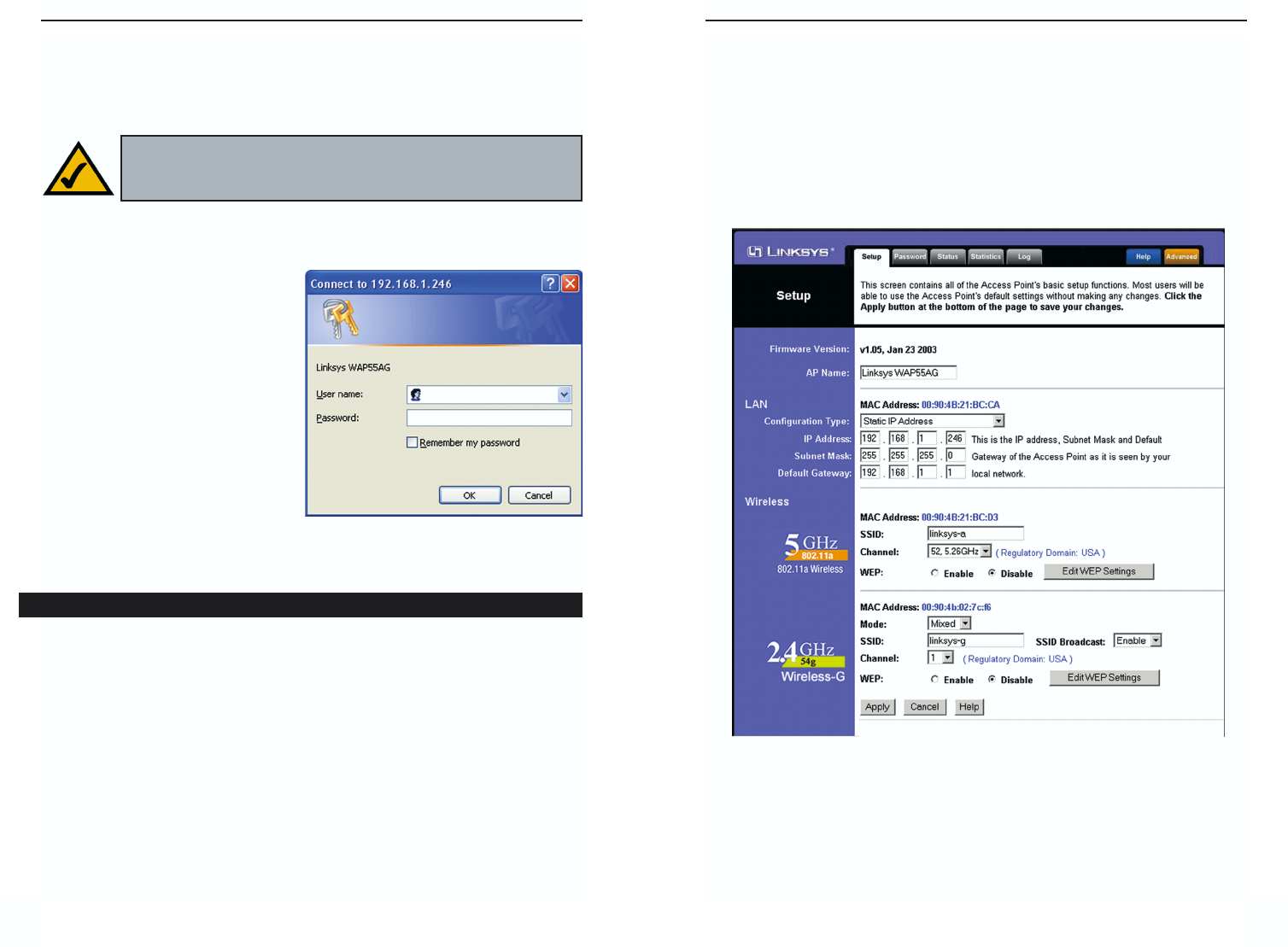
Instant Wireless® Series
14
Chapter 6: Configuring the Dual-
Band Wireless A + G Access Point
The Access Point’s settings can be configured through your web browser with
the Web-Based Utility. This chapter explains how to configure the Access Point
in this manner.
Type the Access Point’s IP Address
into your web browser’s address
field. (The default IP address is
192.168.1.246.) (Should you need to
learn what IP Address the Access
Point presently uses, run the Setup
Wizard. It will scan the Access Point
and give you its IP Address.) Press
the Enter key and the following
screen, shown in Figure 6-1, will
appear. Leave the User Name field
blank. The first time you open the
Web-Based Utility, use the default password admin. You can set a new pass-
word from the Password tab.
The first screen that appears, shown in Figure 6-2, displays the Setup tab. This
allows you to change the Access Point’s general settings. These settings are
described here. Click the Apply button to apply your changes or Cancel to can-
cel your changes. If you require online help, click the Help button.
Firmware. This will display the Access Point’s current firmware version.
Firmware can be upgraded from the Help tab.
Access Point Name. You may assign any name to the Access Point, which is
how the Access Point is identified on your network. Unique, memorable names
are helpful, especially if you are employing multiple access points on the same
network. Verify this is the name you wish to use and click the Apply button to
set it.
Figure 6-1
The Setup Tab
Note: The Access Point is designed to function properly after
using the Setup Wizard. This chapter is provided solely for those
who wish to perform more advanced configuration or monitoring.
Dual-Band Wireless A + G Access Point
MAC Address. The MAC Address of the LAN interface - connected through
the LAN Port - is displayed here.
Configuration Type. This selection tells the Access Point how IP Addresses
are determined on your network. If you are using a DHCP server on your net-
work to automatically generate different IP Addresses to each device, select
Automatic Configuration - DHCP. Select Static IP Address if each device
uses its own IP Address. The Access Point’s default IP Address, Subnet Mask,
and Default Gateway will appear in the appropriate fields.
Fields for configuring your wireless connections, both 802.11a and 802.11g-
draft are located under this information. You must configure any wireless stan-
dard you are using on your network.
MAC Address. The first line of data provided about both wireless standards is
the MAC Address of the wireless interface.
15
Figure 6-2
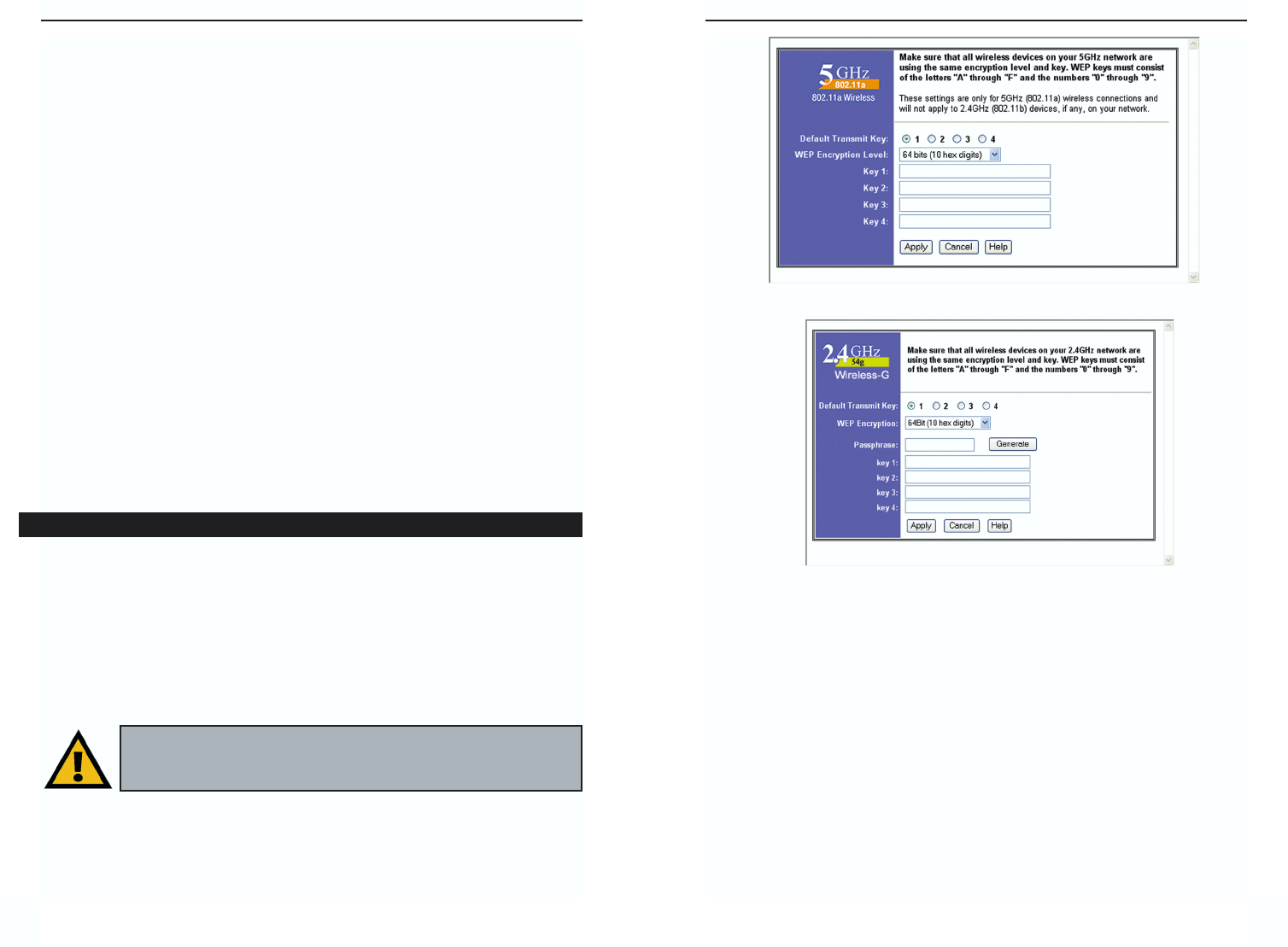
Dual-Band Wireless A + G Access Point
17
Instant Wireless® Series
16
From the pull-down menu, select the type of WEP encryption you wish to use.
If you are using 802.11a wireless technology, you will need to enter the key
manually.
If you are using 802.11g-draft wireless technology and wish to use a WEP
Passphrase, it can be a maximum of 16 alphanumeric characters. This
passphrase may not work with non-Linksys products due to possible incom-
patibility with other vendors’ passphrase generators. The WEP Key can be gen-
erated using your Passphrase or you can enter it manually. Type that here.
Figure 6-3
SSID. The SSID is the unique name shared among all points in a wireless net-
work. The SSID must be identical for all points in the wireless network. It is
case sensitive and must not exceed 32 alphanumeric characters, which may be
any keyboard character. Make sure this setting is the same for all points in your
wireless network.
Channel. Select the appropriate channel from the list provided to correspond
with your network settings. This should be between 1 and 11 (in North
America) for 2.4GHz/802.11b devices and 36 and 64 (in North America) for
5GHz/802.11a devices. All points in your wireless network must use the same
channel in order to function correctly.
WEP. The WEP Encryption method is Disabled by default. To enable WEP,
click the WEP Key Setting button.
Mode. This option works only for 802.11b and 802.11g-draft devices in your
wireless network. Select Mixed and both Wireless-G and Wireless-B comput-
ers will be allowed on the network, but the speed will be reduced. Select G-
Only for maximum speed, but no Wireless-B users will be allowed on the net-
work.
Click the Apply button to apply your changes or Cancel to cancel your
changes. If you require online help, click the Help button.
Setting WEP Encryption through the Web-based Browser Utility is done by
clicking the WEP Key Setting button on the Setup Screen for any type of wire-
less device used on your network.
This will open the WEP key setting screen. This screen is shown in Figure 6-3
for 802.11a wireless products and Figure 6-4 for 802.11g-draft wireless prod-
ucts. Select the WEP encryption for the type(s) of wireless technology you are
using. From this screen, you can select the type of WEP encryption to use as
well as set the WEP Key for that encryption.
WEP Encryption
Figure 6-4
Important: Always remember that each point in your wireless net-
work MUST use the same WEP Encryption method and encryption
key or your wireless network will not function properly.
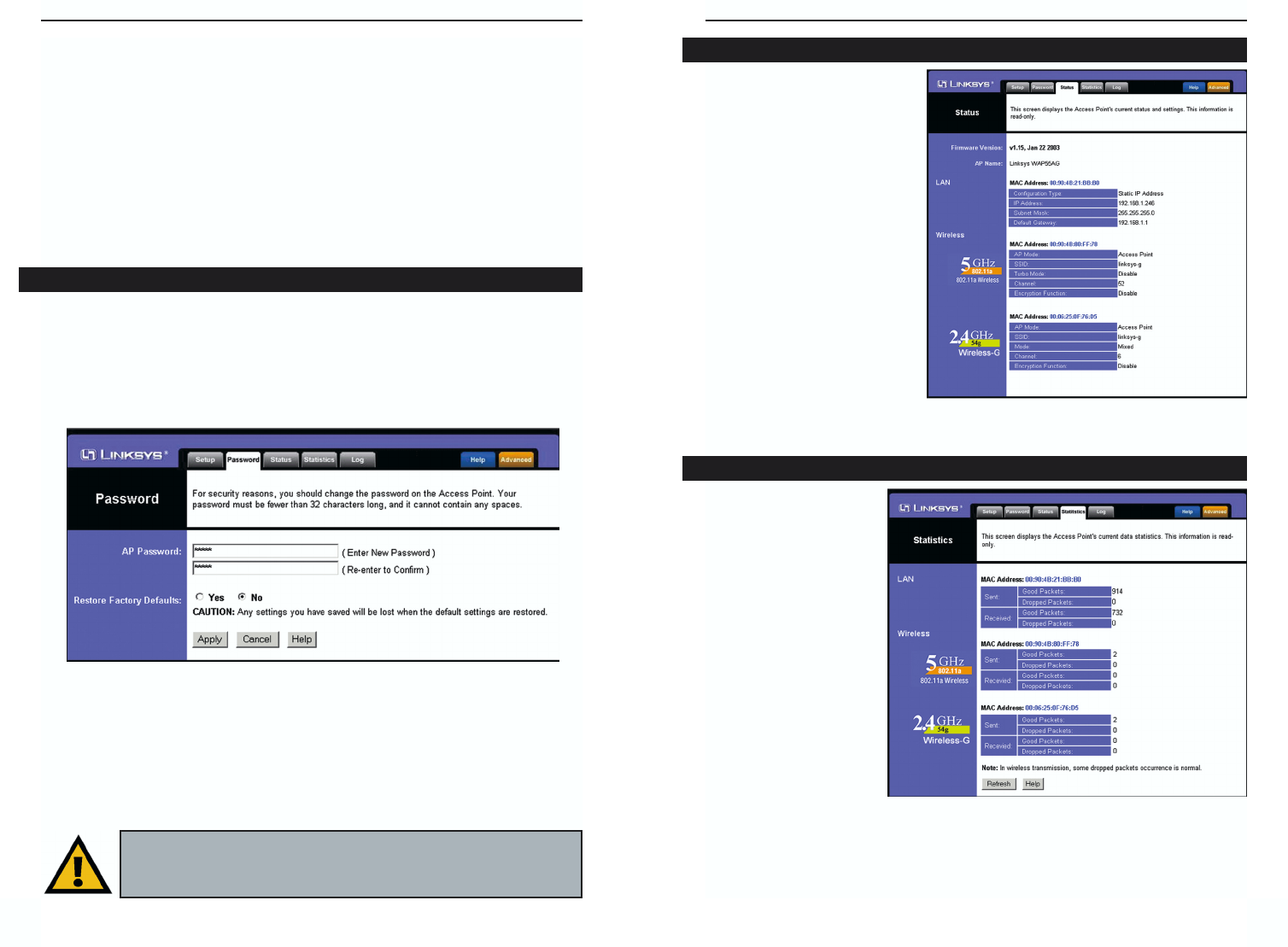
Dual-Band Wireless A + G Access Point
The Status tab, shown in
Figure 6-6, displays current
information on the Access
Point, its settings and perform-
ance.
The information displayed in
these fields reflects the set-
tings that you saved on the
Setup tab. For any information
about what these settings
mean, turn back to the appro-
priate heading in the section
for the Setup tab.
The Statistics tab, shown
in Figure 6-7, displays
information on how well
the Access Point is trans-
mitting data. It shows the
amount of data packets
dropped with those trans-
mitted. Remember, some
packet loss is common in
networking.
To update the statistics,
click the Refresh button.
Click the Help button for
more information about
this screen
19
The Status Tab
Figure 6-6
Instant Wireless® Series
18
The WEP key must consist of the letters “A” through “F” and the numbers “0”
through “9” and should be 10 characters in length for 64-bit encryption or 26
characters in length for 128-bit encryption. (When using 802.11a wireless tech-
nology, 152-bit encryption is also available. The WEP key under this setting
should be 32 characters in length.) All points in your wireless network must use
the same WEP key to utilize WEP encryption.
Once the Passphrase is entered, click the Generate key to generate a WEP key.
Click the Apply button to apply your changes and return to the Setup tab or
Cancel to cancel your changes. To clear any of the information you’ve typed
but not yet applied, click the Clear button.
The Password tab, shown in Figure 6-5, allows you to change the Access Point’s
password and restore factory defaults.
Changing the sign-on password for the Access Point is as easy as typing the
password into the AP Password field. Then, type it again into the second field
to confirm.
To restore the Access Point’s factory default settings, click the Ye s button
beside Restore Factory Defaults.
Click the Apply button to apply your changes or Cancel to cancel your
changes. If you require online help, click the Help button.
Figure 6-5
The Password Tab
Important: Restoring the Access Point’s factory defaults will erase
all of your settings (WEP Encryption, Wireless and LAN settings,
etc.), and replace them with the factory defaults.
The Statistics Tab
Figure 6-7
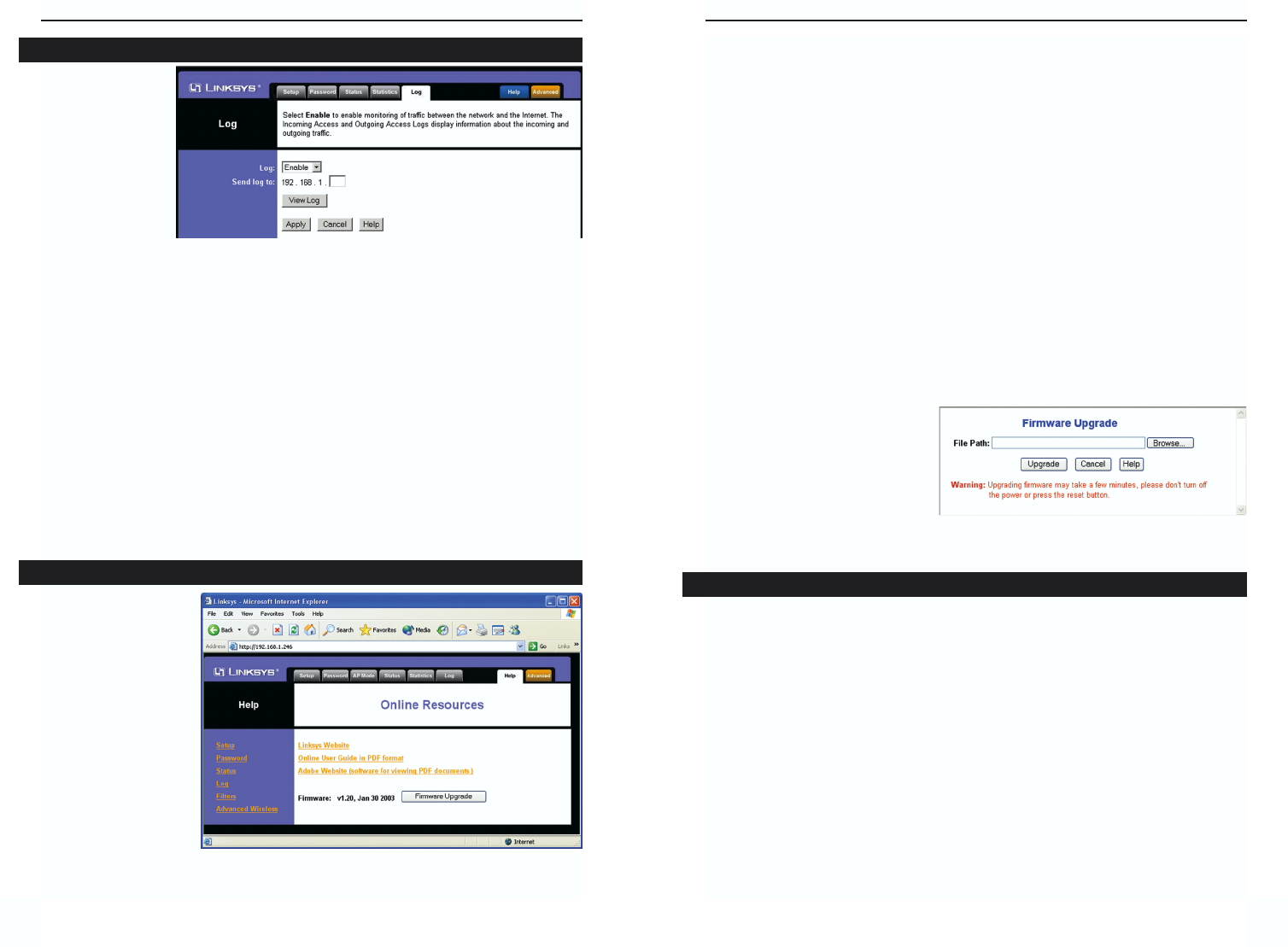
Dual-Band Wireless A + G Access Point
21
Instant Wireless® Series
20
The following resources require an Internet connection in order to access them.
Click the Linksys Website link to connect to the Linksys homepage.
For an Online Manual in PDF format, click that text link. The manual will
appear in Adobe pdf format. If you do not have the Adobe PDF Reader installed
on your computer, click the Adobe Website link to download this software.
Firmware can be upgraded by clicking the Upgrade Firmware link. Do not
upgrade your firmware unless you are experiencing problems with the Access
Point.
UPGRADING FIRMWARE:
Before upgrading the Access Point’s firmware, be sure to download the
firmware from Linksys’s website at www.linksys.com.
Once that is done, click the Upgrade Firmware link on the Help Tab. This will
bring up the screen shown in Figure 6-10.
Type in the location of the
firmware’s file or click the
Browse button to find the file.
Then, click the Upgrade button
to upgrade the firmware. To can-
cel the procedure, click Cancel
or for more information, click
Help.
The Filters tab, shown in Figure 6-11, allows you to block and allow certain
computers, by their MAC Address, from communicating with the Access Point.
To enable filtering of computers by their MAC Addresses, click the Enable
radio button. To disable this feature, click the radio button by Disable.
Type the MAC Addresses for those PCs you wish to allow access to the Access
Point in the MAC Address fields. As long as Filtering is enabled, PCs with
MAC Addresses not entered in the MAC Address field will not be allowed to
communicate with the Access Point.
Figure 6-10
To view a log of
the Access Point’s
activity, select the
Log tab, shown in
Figure 6-8.
Log. To enable
permanent log-
ging activity, click
the Enable radio
button beside Log. The default setting for this function is Disable.
If you have chosen to monitor the Access Point’s traffic, then you can designate
a PC that will receive permanent log files periodically. In the Send Log to field,
enter the IP address of this PC. To view these permanent logs, you must use
Logviewer software, which can be downloaded free of charge from
www.linksys.com.
To see a temporary log of the Access Point’s most recent activities, click the
View Log button.
Click the Apply button to apply your changes or Cancel to cancel your
changes. If you require online help, click the Help button.
For help on the vari-
ous tabs in this Web-
based Utility, along
with upgrading the
Access Point’s
firmware and view-
ing this User Guide,
click the Help tab,
shown in Figure 6-9.
Clicking the names of
the tabs on the left-
hand side of the
screen brings up help
for those tabs.
The Log Tab
Figure 6-8
The Help Tab
Figure 6-9
The Filters Tab
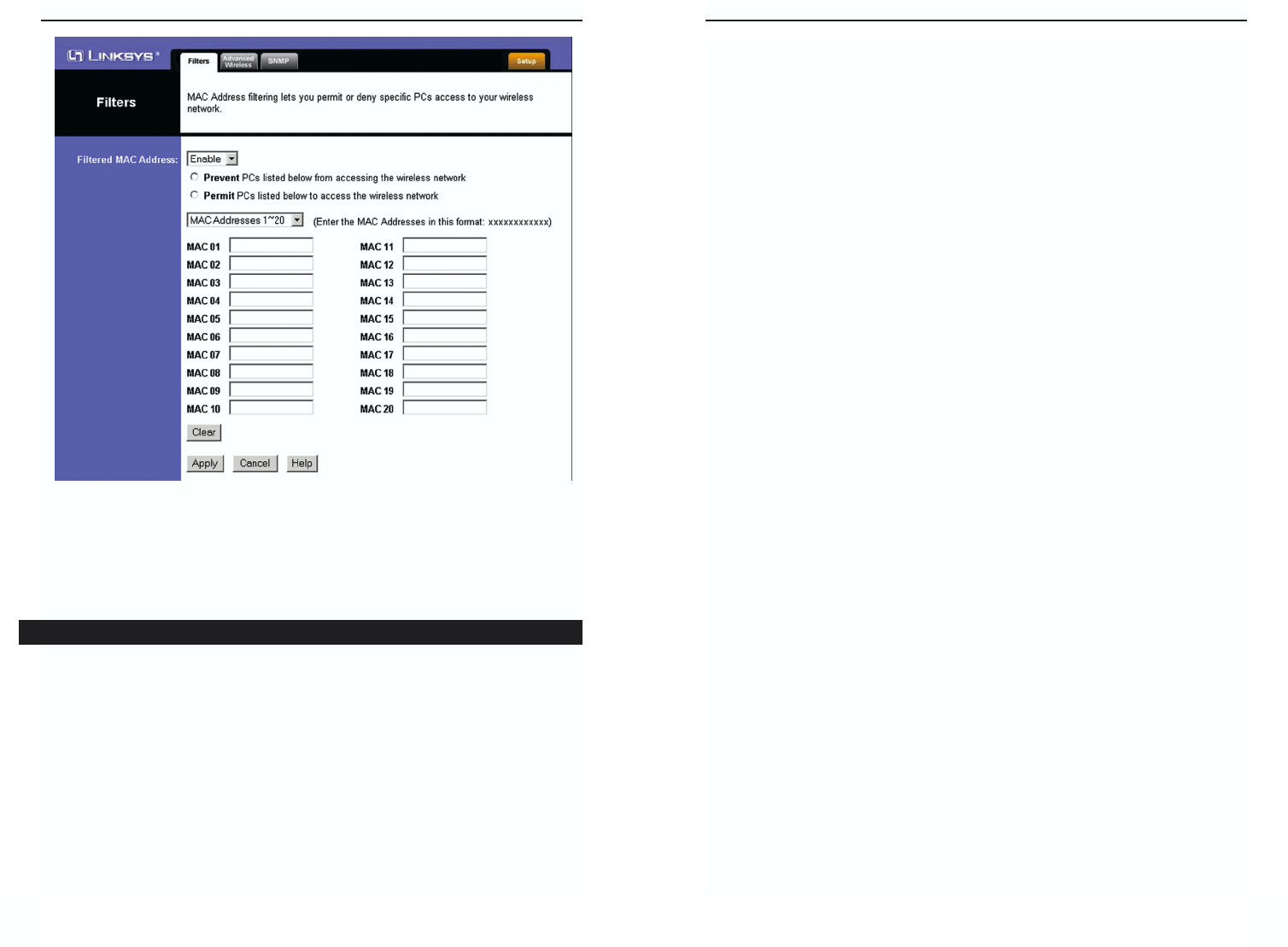
Dual-Band Wireless A + G Access Point
23
Instant Wireless® Series
When you’ve completed making any changes on this tab, click the Apply button to
save those changes or Cancel to exit the Web-based Utility without saving changes.
To clear any of the information you’ve typed by not yet applied, click the Clear but-
ton. For more information on this tab, you can click the Help button.
Before making any changes to the Advanced Wireless tab, shown in Figure 6-12,
please check your wireless settings on other systems, as these changes will alter
the effectiveness of the Access Point. In most cases, these settings do not need
to be changed.
The following settings are used in both wireless settings:
Transmission Rates. The basic transfer rates should be set depending on the
speed of your wireless network. You can select from a range of transmission
speeds or select Best to have the Access Point automatically engage the net-
work’s optimum speed.
22
Transmit Power. The greater the transmit power used, the larger the area a
wireless network covers. To minimize the likelihood of eavesdropping by unau-
thorized wireless users, do not use more transmit power than necessary to cover
the range needed for your wireless network. Try using the Router at different
levels of transmit power, and determine how much transmit power is needed to
reach the wireless client, such as a PC, or access point that is farthest from the
Router. Then select the appropriate level of transmit power (Full, Half,
Quarter, Eighth, or Min) from the drop-down menu. The default value is Full.
Authentication Type. This setting allows the Access Point to authenticate com-
munication with the wireless devices in your network. You may choose between
Auto, Open System or Shared Key. With the Shared Key setting, all wire-
less devices must have the same WEP keys so that the Access Point and the
client can authenticate each other and start transmitting data. With the Open
System setting, any device can join a network without performing any securi-
ty check. The Authentication Type default setting is to Auto, which means that
the Access Point will automatically detect whether a wireless device is set to
Shared Key, Open System, and transmit data appropriately.
Beacon Interval. This value indicates the frequency interval of the beacon. A
beacon is a packet broadcast by the Access Point to keep the network synchro-
nized. A beacon includes the wireless LAN service area, the AP address, the
Broadcast destination addresses, a time stamp, Delivery Traffic Indicator
Maps, and the Traffic Indicator Message (TIM).
RTS Threshold. This value should remain at its default setting of 2,346.
Should you encounter inconsistent data flow, only minor modifications are rec-
ommended.
Fragmentation Length. This specifies the maximum size a data packet will
be before splitting and creating a new packet and should remain at its default
setting of 2,346. A smaller setting means smaller packets, which will create
more packets for each transmission. If you have decreased this value and expe-
rience high packet error rates, you can increase it again, but it will likely
decrease overall network performance. Only minor modifications of this value
are recommended.
The Advanced Wireless Tab
Figure 6-11
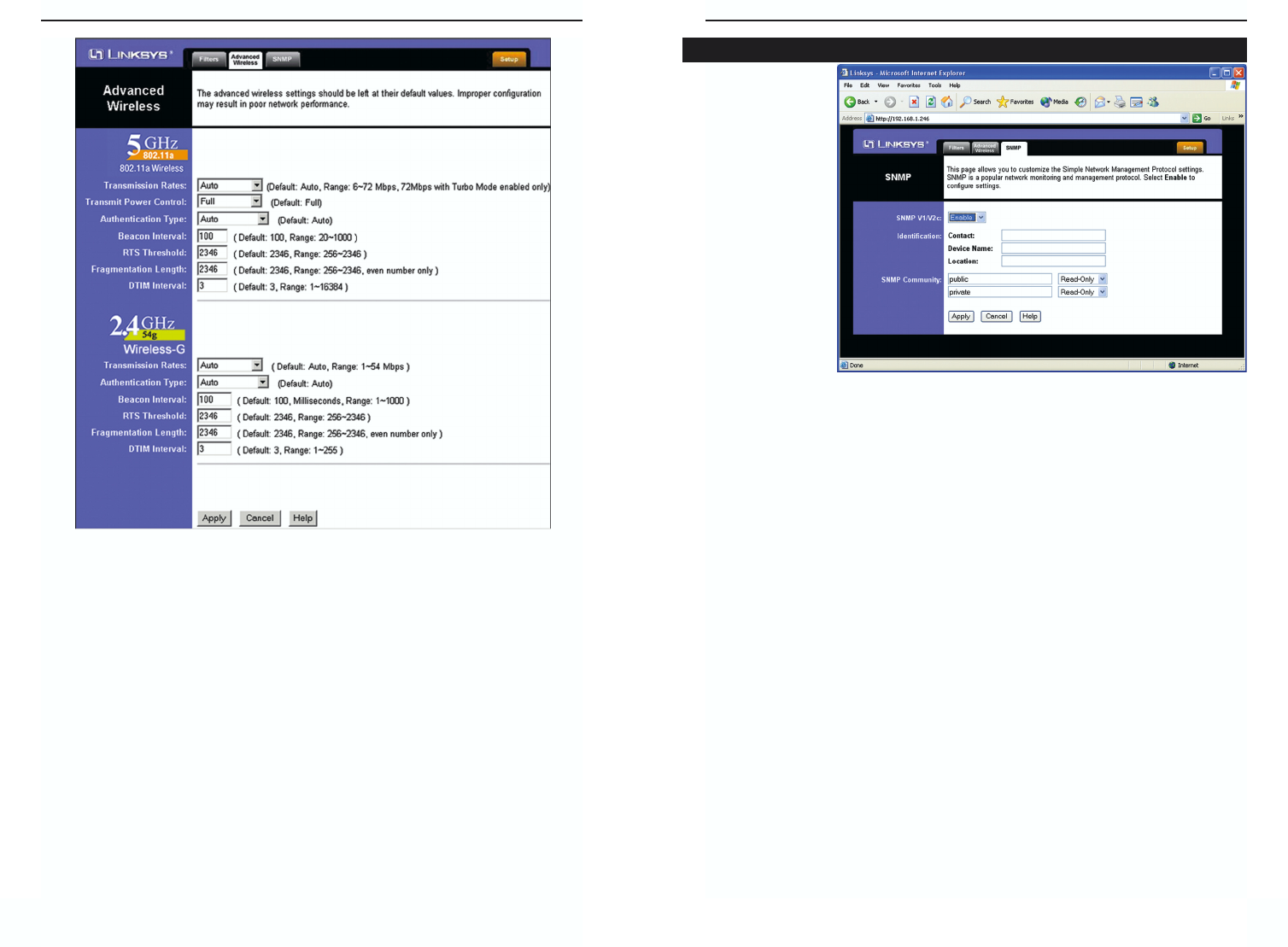
Dual-Band Wireless A + G Access Point
The SNMP tab,
shown in Figure
6-15, allows you
to customize the
Simple Network
Management
Protocol (SNMP)
settings. SNMP
is a popular net-
work monitoring
and management
protocol.
The Identification settings let you designate the Contact, Device Name, and
Location information for the Access Point. The SNMP Community settings
allow names to be assigned to any SNMP communities that have been set up in
the network. You can define two different SNMP communities, with the default
names being Public and Private.
SNMP V1/V2c. To enable the SNMP support feature, select Enable.
Otherwise, select Disable.
Identification. In the Contact field, enter contact information for the Access
Point. In the Device Name field, enter the name of the Access Point. In the
Location field, specify the area or location where the Access Point resides.
SNMP Community. You may change the name from its default, Public. Enter
a new name in the Public field. Then configure the community's access as
either Read-Only or Read-Write.You may change the name from its default,
Private. Enter a new name in the Private field. Then configure the communi-
ty's access as either Read-Only or Read-Write.
When you’ve completed making any changes on this tab, click the Apply but-
ton to save those changes or Cancel to cancel your changes. For more infor-
mation on this tab, you can click the Help button.
25
Instant Wireless® Series
DTIM Interval. This value indicates the interval of the Delivery Traffic
Indication Message (DTIM). A DTIM field is a countdown field informing
clients of the next window for listening to broadcast and multicast messages.
When the Access Point has buffered broadcast or multicast messages for asso-
ciated clients, it sends the next DTIM with a DTIM Interval value. Access
Point Clients hear the beacons and awaken to receive the broadcast and multi-
cast messages.
Transmission Power. (This applies to 5GHz/802.11a devices only.) This
option allows you to set the power at which the Access Point transmits. This
will allow you to prevent transmission outside your network radius and possi-
ble lapses in network security. Selecting a value other than FULL may limit the
coverage area and data rates of your wireless PCs.
When you’ve completed making any changes on this tab, click the Apply but-
ton to save those changes or Cancel to exit the Web-based Utility without sav-
ing changes. For more information on this tab, you can click the Help button.
24
Figure 6-15
The SNMP Tab
Figure 6-14

Dual-Band Wireless A + G Access Point
What is Ad-hoc?
An Ad-hoc wireless LAN is a group of computers, each with a WLAN adapter,
connected as an independent wireless LAN. An Ad-hoc wireless LAN is appli-
cable at a departmental scale for a branch or SOHO operation.
What is Infrastructure?
An integrated wireless and wired LAN is called an Infrastructure configura-
tion. Infrastructure is applicable to enterprise scale for wireless access to a cen-
tral database, or wireless application for mobile workers.
What is Roaming?
Roaming is the ability of a portable computer user to communicate continu-
ously while moving freely throughout an area greater than that covered by a
single Access Point. Before using the roaming function, the workstation must
make sure that it is the same channel number as the Access Point of the dedi-
cated coverage area.
To achieve true seamless connectivity, the wireless LAN must incorporate a
number of different functions. Each node and Access Point, for example, must
always acknowledge receipt of each message. Each node must maintain contact
with the wireless network even when not actually transmitting data. Achieving
these functions simultaneously requires a dynamic RF networking technology
that links Access Points and nodes. In such a system, the user’s end node under-
takes a search for the best possible access to the system. First, it evaluates such
factors as signal strength and quality, as well as the message load currently
being carried by each Access Point and the distance of each Access Point to the
wired backbone. Based on that information, the node next selects the right
Access Point and registers its address. Communications between end node and
host computer can then be transmitted up and down the backbone.
As the user moves on, the end node’s RF transmitter regularly checks the sys-
tem to determine whether it is in touch with the original Access Point or
whether it should seek a new one. When a node no longer receives acknowl-
edgment from its original Access Point, it undertakes a new search. Upon find-
ing a new Access Point, it then re-registers, and the communication process
continues.
What is BSS ID?
A specific Ad-hoc LAN is called a Basic Service Set (BSS). Computers in a
BSS must be configured with the same BSS ID.
27
Instant Wireless® Series
Appendix A: Troubleshooting
This chapter provides solutions to problems usually encountered during the
installation and operation of the Access Point. Read the description below to
solve your problems. If you can’t find an answer here, check the Linksys web-
site at www.linksys.com.
Can the Access Point act as my DHCP Server?
No. The Access Point is nothing more than a wireless hub, and as such cannot
be configured to handle DHCP capabilities.
Can I run an application from a remote computer over the wireless net-
work?
This will depend on whether or not the application is designed to be used over
a network. Consult the application’s user guide to determine if it supports oper-
ation over a network.
Can I play multiplayer games with other users of the wireless network?
Yes, as long as the game supports multiple players over a LAN (local area net-
work). Refer to the game’s user guide for more information.
What IEEE 802.11a features are supported?
The product supports the following IEEE 802.11a functions:
• OFDM protocol
• Multi-Channel Roaming
• Automatic Rate Selection
• RTS/CTS feature
• Fragmentation
What IEEE 802.11b features are supported?
The product supports the following IEEE 802.11 functions:
• CSMA/CA plus Acknowledge protocol
• Multi-Channel Roaming
• Automatic Rate Selection
• RTS/CTS feature
• Fragmentation
• Power Management
26
Frequently Asked Questions

Dual-Band Wireless A + G Access Point
Can Instant Wireless products support file and printer sharing?
Instant WirelessTM products perform the same function as LAN products.
Therefore, Instant WirelessTM products can work with Netware, Windows
NT/2000, or other LAN operating systems to support printer or file sharing.
What is WEP?
WEP is Wired Equivalent Privacy, a data privacy mechanism based on a 40-bit
shared-key algorithm, as described in the IEEE 802.11 standard.
What is a MAC Address?
The Media Access Control (MAC) address is a unique number assigned by the
manufacturer to any Ethernet networking device, such as a network adapter,
that allows the network to identify it at the hardware level. For all practical pur-
poses, this number is usually permanent. Unlike IP addresses, which can
change every time a computer logs on to the network, the MAC address of a
device stays the same, making it a valuable identifier for the network.
How do I avoid interference?
Using multiple Access Points on the same channel and in close proximity to
one another will generate interference. When employing multiple Access
Points, be sure to operate each one on a different channel (frequency).
How do I reset the Access Point?
Press the Reset button on the back of the Access Point for about ten seconds.
This will reset the unit to its default settings.
How do I resolve issues with signal loss?
There is no way to know the exact range of your wireless network without test-
ing. Every obstacle placed between an Access Point and wireless PC will cre-
ate signal loss. Leaded glass, metal, concrete floors, water and walls will inhib-
it the signal and reduce range. Start with your Access Point and your wireless
PC in the same room and move it away in small increments to determine the
maximum range in your environment.
You may also try using different channels, as this may eliminate interference
affecting only one channel. Also, due to FCC regulations, more power may be
transmitted, using 802.11a, on channels 52, 56, 60 and 64, than on the lower
channels. Lastly, check the Advanced tab of the Web-Based Utility and make
sure that FULL is selected in the Transmission Rate field.
Does the Turbo Mode work with Windows XP PCs?
No. The Turbo Mode does not work with Windows XP PCs.
29
Instant Wireless® Series
What is ISM band?
The FCC and their counterparts outside of the U.S. have set aside bandwidth
for unlicensed use in the ISM (Industrial, Scientific and Medical) band.
Spectrum in the vicinity of 2.4 GHz, in particular, is being made available
worldwide. This presents a truly revolutionary opportunity to place convenient
high speed wireless capabilities in the hands of users around the globe.
What is Spread Spectrum?
Spread Spectrum technology is a wideband radio frequency technique devel-
oped by the military for use in reliable, secure, mission-critical communica-
tions systems. It is designed to trade off bandwidth efficiency for reliability,
integrity, and security. In other words, more bandwidth is consumed than in the
case of narrowband transmission, but the trade-off produces a signal that is, in
effect, louder and thus easier to detect, provided that the receiver knows the
parameters of the spread-spectrum signal being broadcast. If a receiver is not
tuned to the right frequency, a spread-spectrum signal looks like background
noise. There are two main alternatives, Direct Sequence Spread Spectrum
(DSSS) and Frequency Hopping Spread Spectrum (FHSS).
What is DSSS? What is FHSS? And what are their differences?
Frequency Hopping Spread Spectrum (FHSS) uses a narrowband carrier that
changes frequency in a pattern that is known to both transmitter and receiver.
Properly synchronized, the net effect is to maintain a single logical channel. To
an unintended receiver, FHSS appears to be short-duration impulse noise.
Direct Sequence Spread Spectrum (DSSS) generates a redundant bit pattern for
each bit to be transmitted. This bit pattern is called a chip (or chipping code).
The longer the chip, the greater the probability that the original data can be
recovered. Even if one or more bits in the chip are damaged during transmis-
sion, statistical techniques embedded in the radio can recover the original data
without the need for retransmission. To an unintended receiver, DSSS appears
as low power wideband noise and is rejected (ignored) by most narrowband
receivers.
Would the information be intercepted while transmitting on air?
WLAN features two-fold protection in security. On the hardware side, as with
Direct Sequence Spread Spectrum technology, it has the inherent security fea-
ture of scrambling. On the software side, the WLAN series offers the encryp-
tion function (WEP) to enhance security and access control. Users can set it up
depending upon their needs.
28

Dual-Band Wireless A + G Access Point
Appendix B: Setting Up the TCP/IP and
IPX Protocols
Before a computer can communicate with the Access Point, it must be config-
ured with the TCP/IP protocol. If you know how to set up TCP/IP on your com-
puters, do so now. Otherwise, use the guidelines below to help get TCP/IP
installed on all of the computers that need to communicate with the Access
Point. If you are unable to successfully install TCP/IP on one or more comput-
ers after following the directions, contact the manufacturer of your computers'
network operating system for further assistance. Check with your network
administrator for your TCP/IP settings.
The directions below provide general guidelines for coming up with IP address-
es and subnet masks. Check with your network administrator to see if you need
to use specific IP addresses or DHCP settings.
First, each computer on the network will require an IP address, which is a series
of numbers, separated by periods, identifying the PC on the network. To make
things simple, you should use the following numbering scheme:
192.168.1.X
In this example, X is a unique, arbitrarily assigned number from 1 to 254. Each
computer must have its own unique X number. Note: Never use 0, 250 or 255
for X. These numbers are reserved by TCP/IP for other uses.
For example, if you have three computers, you could number them as follows:
192.168.1.17
192.168.1.44
192.168.1.126
In this case, 17, 44, and 126 are arbitrary numbers between 1 and 254.
Each computer will also require a subnet mask, which is a numerical “filter”
that tells a computer what kinds of TCP/IP data packets to accept. If you’re not
sure which mask to use, the following mask is recommended:
255.255.255.0
31
Instant Wireless® Series
Does the Access Point function as a firewall?
No. The Access Point is only a bridge from wired Ethernet to wireless clients.
I have excellent signal strength, but I cannot see my network.
WEP is probably enabled on the Access Point, but not on your wireless adapter
(or vice versa). Verify that the same WEP Keys and levels (64, 128 or 152) are
being used on all nodes on your wireless network.
What is the maximum number of users the Access Point facilitates?
No more than 65, but this depends on the volume of data and may be less if
many users create a large amount of network traffic.
How many channels/frequencies are available with the Access Point?
Using 802.11a, there are eight available frequencies, ranging from 5.15GHz to
5.32GHz. Using 802.11b, there are eleven available channels, ranging from 1
to 11.
What is Turbo mode?
Turbo mode allows high-speed connections, but severely limits range. Turbo
mode must be enabled on both the Access Point and the wireless PCs to func-
tion. Turbo mode is not compatible with Windows XP and may only function
with Linksys 5GHz wireless adapters.
What is the difference in range between 802.11a and 802.11b products?
Overall, range will be a little
less in a typical environment,
while higher speeds may be
achieved with 802.11a, through-
put degrades more quickly. (See
Figure A-1.)
30
Setting Up TCP/IP in Windows
Figure A-1

Dual-Band Wireless A + G Access Point
1. Click the Start button, select Settings, and open the Control Panel. Inside
the Control Panel, double-click the Network icon.
2. When the Network window appears, click the Protocols tab. Then, click
the Add button.
3. Find the TCP/IP protocol in the Select Network Protocol field. Click it
once and then click the OK button.
4. When asked if you want to use DHCP, choose No.
5. If asked to supply your Windows NT CD, do so. NT will copy the neces-
sary files to your system. You may have to switch between the Access
Point’s Setup CD and the NT CD.
6. When TCP/IP appears in the Network Protocols window, click the
Bindings tab. Windows will store your new bindings.
7. Click the Protocols tab. Then, select TCP/IP.
8. Click the Properties button. Select the type of network adapter you have
from the Adapters box and select Specify an IP Address.
9. Enter the computer’s IP Address and Subnet Mask. Check with your net-
work administrator for your settings.
10. Enter your Default Gateway if you have one.
11. When you finish, click the OK button. If NT asks about WINS, ignore it.
12. When the Network window reappears, click the Close button. Restart your
computer when prompted. TCP/IP has now been successfully installed.
1. Click the Start button, select Settings, and open the Control Panel. Inside
the Control Panel, double-click the Network icon.
33
Instant Wireless® Series
The following instructions are provided as examples for reference only. For
complete instructions on installing and troubleshooting TCP/IP and IPX, con-
sult your Windows operating system documentation.
1. Click the Start button, select Settings, and open the Control Panel. Inside
the Control Panel, double-click the Network icon.
2. If the TCP/IP Protocol is listed for your network adapter, go to step five.
Otherwise, click the Add button.
3. When the Component Type window appears, select Protocol and click the
Add button.
4. Select Microsoft in the Manufacturers list and choose TCP/IP in the
Network Protocols list. Then, click the OK button.
5. When the Network window reappears, click TCP/IP. Then, click the
Properties button.
6. Select Specify an IP Address.
7. Enter an IP Address for the computer, along with a Subnet Mask. Click the
OK button. If you do not have these values, consult your network adminis-
trator.
8. When the Network window reappears, click the OK button. Restart your
machine. TCP/IP has now been successfully installed.
1. Click the Start button, select Settings, and open the Control Panel. Inside
the Control Panel, double-click the Network icon.
2. If the TCP/IP Protocol is listed for your network adapter, go to step four.
Otherwise, click the Add button.
3. When the Component Type window appears, select Protocol and click the
Add button.
4. Select Microsoft in the Manufacturers list and choose IPX/SPX protocol
in the Network Protocols list. Then, click the OK button.
32
TCP/IP Setup for Windows NT 4.0
NNoottee::a Default Gateway is not required. Check with your network administrator.
IPX Setup for Windows NT 4.0
TCP/IP Setup for Windows 95, 98, and Millennium
IPX Setup for Windows 95, 98, and Millennium

Dual-Band Wireless A + G Access Point
4. Select NWLink IPX/SPX/NetBIOS Compatible Transport Protocol
from the list and click the OK button.
5. When the Network window reappears, click the OK button. Restart your
computer. NWLink IPX/SPX/NetBIOS Compatible Transport Protocol has
now been successfully installed.
1. Click the Start button and open the Control Panel.
2. Double click the Network and Internet Connections icon.
3. Double click the Network Connections icon.
4. Right click the Local Area Connection icon and select Properties.
5. If the TCP/IP Protocol is listed for your network adapter, go to step five.
Otherwise, click the Install button.
6. When the Component Type window appears, select Protocol, and click the
Add button.
7. Select Internet Protocol (TCP/IP) from the list and click the OK button.
8. When the Local Area Connection Properties window reappears, select
TCP/IP, and click the Properties button.
9. Select Use the following IP Address.
10. Enter an IP Address for the computer, along with a Subnet Mask and
Default Gateway. Then, click the OK button. If you do not have these val-
ues, consult your network administrator.
11. When the Local Area Connection Properties window reappears, click the
OK button. TCP/IP has now been successfully installed..
35
Instant Wireless® Series
2. When the Network window appears, click the Protocols tab. Then, click
the Add button.
3. Find the IPX/SPX protocol in the Select Network Protocol field. Click it
once and click the OK button.
1. At the Windows 2000 desktop, right click My Network Places and select
Properties. Then, right click Local Area Connection. Choose Properties.
2. If the TCP/IP Protocol is listed for your network adapter, go to step five.
Otherwise, click the Install button.
3. When the Component Type window appears, select Protocol, and click the
Add button.
4. Select Internet Protocol (TCP/IP) from the list and click the OK button.
5. When the Local Area Connection Properties window reappears, select
TCP/IP, and click the Properties button.
6. Select Use the following IP Address.
7. Enter an IP Address for the computer, along with a Subnet Mask and
Default Gateway. Then, click the OK button. If you do not have these val-
ues, consult your network administrator.
8. When the Local Area Connection Properties window reappears, click the
OK button. TCP/IP has now been successfully installed.
1. At the Windows 2000 desktop, right click My Network Places. Then right
click Local Area Connection. Choose Properties.
2. If the NWLink IPX/SPX/NetBIOS Compatible Transport Protocol is listed
for your network adapter, click the Cancel button. Otherwise, click the
Install button.
3. When the Component Type window appears, select Protocol and click the
Install button.
34
TCP/IP Setup for Windows XP
TCP/IP Setup for Windows 2000
IPX Setup for Windows 2000

Dual-Band Wireless A + G Access Point
37
Instant Wireless® Series
36
Beacon Interval - A beacon is a packet broadcast by the Access Point to keep
the network synchronized. A beacon includes the wireless LAN service area,
the AP address, the Broadcast destination addresses, a time stamp, Delivery
Traffic Indicator Maps, and the Traffic Indicator Message (TIM).
Bit - A binary digit. The value - 0 or 1-used in the binary numbering system.
Also, the smallest form of data.
Boot - To cause the computer to start executing instructions. Personal comput-
ers contain built-in instructions in a ROM chip that are automatically executed
on startup. These instructions search for the operating system, load it and pass
control to it.
Bridge - A device that interconnects different networks together.
Browser - A browser is an application program that provides a way to look at
and interact with all the information on the World Wide Web or PC. The word
"browser" seems to have originated prior to the Web as a generic term for user
interfaces that let you browse text files online.
BSS (Basic Service Set) - An infrastructure network connecting wireless
devices to a wired network using a single access point.
Buffer - A buffer is a shared or assigned memory area used by hardware
devices or program processes that operate at different speeds or with different
sets of priorities. The buffer allows each device or process to operate without
being held up by the other. In order for a buffer to be effective, the size of the
buffer and the algorithms for moving data into and out of the buffer need to be
considered by the buffer designer. Like a cache, a buffer is a "midpoint holding
place" but exists not so much to accelerate the speed of an activity as to sup-
port the coordination of separate activities.
CSMA/CA (Carrier Sense Multiple Access/Collision Avoidance) - In local
area networking, this is the CSMA technique that combines slotted time-divi-
sion multiplexing with carrier sense multiple access/collision detection
(CSMA/CD) to avoid having collisions occur a second time. This works best if
the time allocated is short compared to packet length and if the number of sit-
uations is small.
CTS (Clear To Send) - An RS-232 signal sent from the receiving station to the
transmitting station that indicates it is ready to accept data.
Appendix C: Glossary
802.11a - One of the IEEE standards for wireless networking hardware.
Products that adhere to a specific IEEE standard will work with each other,
even if they are manufactured by different companies. It specifies a maximum
data transfer rate of 54Mbps and an operating frequency of 5GHz. The 802.11a
standard uses the Orthogonal Frequency Division Multiplexing (OFDM) trans-
mission method. Additionally, the 802.11a standard supports 802.11 features
such as WEP encryption for security.
802.11b - One of the IEEE standards for wireless networking hardware.
Products that adhere to a specific IEEE standard will work with each other,
even if they are manufactured by different companies. The 802.11b standard
specifies a maximum data transfer rate of 11Mbps, an operating frequency of
2.4GHz, and WEP encryption for security. 802.11b networks are also referred
to as Wi-Fi networks.
802.11g - A proposed, but as yet unratified extension of the IEEE 802.11 stan-
dard for wireless networking hardware. The draft 802.11g specifications used
by Linksys specify a maximum data transfer rate of 54Mbps using OFDM
modulation, an operating frequency of 2.4GHz, backward compatibility with
IEEE 802.11b devices, and WEP encryption for security.
Adapter - Printed circuit board that plugs into a PC to add to capabilities or
connectivity to a PC. In a networked environment, a network interface card is
the typical adapter that allows the PC or server to connect to the intranet and/or
Internet.
Ad-hoc Network - An ad-hoc network is a group of computers, each with a
wireless adapter, connected as an independent 802.11 wireless LAN. Ad-hoc
wireless computers operate on a peer-to-peer basis, communicating directly
with each other without the use of an access point. Ad-hoc mode is also
referred to as an Independent Basic Service Set (IBSS) or as peer-to-peer
mode, and is useful at a departmental scale or SOHO operation.
Backbone - The part of a network that connects most of the systems and net-
works together and handles the most data.
Bandwidth - The transmission capacity of a given facility, in terms of how
much data the facility can transmit in a fixed amount of time; expressed in bits
per second (bps).

Dual-Band Wireless A + G Access Point
39
Instant Wireless® Series
38
point), the DSSS signal is recognized as the only valid signal, and interference
is inherently rejected (ignored).
DTIM (Delivery Traffic Indication Message) - A DTIM field is a countdown
field informing clients of the next window for listening to broadcast and mul-
ticast messages. When the AP has buffered broadcast or multicast messages for
associated clients, it sends the next DTIM with a DTIM Interval value. AP
Clients hear the beacons and awaken to receive the broadcast and multicast
messages.
Encryption - A security method that applies a specific algorithm to data in
order to alter the data's appearance and prevent other devices from reading the
information.
ESS (Extended Service Set) - A set of more than two or more BSSs (multiple
access points) forming a single network.
Ethernet - IEEE standard network protocol that specifies how data is placed
on and retrieved from a common transmission medium. Has a transfer rate of
10 Mbps. Forms the underlying transport vehicle used by several upper-level
protocols, including TCP/IP and XNS.
FHSS (Frequency Hopping Spread Spectrum) - FHSS continuously changes
(hops) the carrier frequency of a conventional carrier several times per second
according to a pseudo-random set of channels. Because a fixed frequency is not
used, and only the transmitter and receiver know the hop patterns, interception
of FHSS is extremely difficult.
Firewall - A firewall is a set of related programs, located at a network gateway
server, that protects the resources of a network from users from other networks.
(The term also implies the security policy that is used with the programs.) An
enterprise with an intranet that allows its workers access to the wider Internet
installs a firewall to prevent outsiders from accessing its own private data
resources and for controlling what outside resources to which its own users
have access.
Basically, a firewall, working closely with a router, examines each network
packet to determine whether to forward it toward its destination.
Firmware - Code that is written onto read-only memory (ROM) or program-
mable read-only memory (PROM). Once firmware has been written onto the
ROM or PROM, it is retained even when the device is turned off.
Database - A database is a collection of data that is organized so that its con-
tents can easily be accessed, managed, and updated.
Data Packet - One frame in a packet-switched message. Most data communi-
cations is based on dividing the transmitted message into packets. For example,
an Ethernet packet can be from 64 to 1518 bytes in length.
Default Gateway - The routing device used to forward all traffic that is not
addressed to a station within the local subnet.
DHCP (Dynamic Host Configuration Protocol) - A protocol that lets network
administrators manage centrally and automate the assignment of Internet
Protocol (IP) addresses in an organization's network. Using the Internet's set of
protocol (TCP/IP), each machine that can connect to the Internet needs a
unique IP address. When an organization sets up its computer users with a con-
nection to the Internet, an IP address must be assigned to each machine.
Without DHCP, the IP address must be entered manually at each computer and,
if computers move to another location in another part of the network, a new IP
address must be entered. DHCP lets a network administrator supervise and dis-
tribute IP addresses from a central point and automatically sends a new IP
address when a computer is plugged into a different place in the network.
DHCP uses the concept of a "lease" or amount of time that a given IP address
will be valid for a computer. The lease time can vary depending on how long a
user is likely to require the Internet connection at a particular location. It's espe-
cially useful in education and other environments where users change fre-
quently. Using very short leases, DHCP can dynamically reconfigure networks
in which there are more computers than there are available IP addresses.
DHCP supports static addresses for computers containing Web servers that
need a permanent IP address.
Download - To receive a file transmitted over a network. In a communications
session, download means receive, upload means transmit.
DSSS (Direct-Sequence Spread Spectrum) - DSSS generates a redundant bit
pattern for all data transmitted. This bit pattern is called a chip (or chipping
code). Even if one or more bits in the chip are damaged during transmission,
statistical techniques embedded in the receiver can recover the original data
without the need for retransmission. To an unintended receiver, DSSS appears
as low power wideband noise and is rejected (ignored) by most narrowband
receivers. However, to an intended receiver (i.e. another wireless LAN end-

Dual-Band Wireless A + G Access Point
IP Address - In the most widely installed level of the Internet Protocol (IP)
today, an IP address is a 32-binary digit number that identifies each sender or
receiver of information that is sent in packet across the Internet. When you
request an HTML page or send e-mail, the Internet Protocol part of TCP/IP
includes your IP address in the message (actually, in each of the packets if more
than one is required) and sends it to the IP address that is obtained by looking
up the domain name in the Uniform Resource Locator you requested or in the
e-mail address you're sending a note to. At the other end, the recipient can see
the IP address of the Web page requestor or the e-mail sender and can respond
by sending another message using the IP address it received.
IPX (Internetwork Packet EXchange) - A NetWare communications protocol
used to route messages from one node to another. IPX packets include network
addresses and can be routed from one network to another.
ISM band - The FCC and their counterparts outside of the U.S. have set aside
bandwidth for unlicensed use in the ISM (Industrial, Scientific and Medical)
band. Spectrum in the vicinity of 2.4 GHz, in particular, is being made avail-
able worldwide. This presents a truly revolutionary opportunity to place con-
venient high-speed wireless capabilities in the hands of users around the globe.
LAN (Local Area Network) - A group of computers and associated devices that
share a common communications line and typically share the resources of a
single processor or server within a small geographic area (for example, within
an office building).
MAC (Media Access Control) Address - A unique number assigned by the
manufacturer to any Ethernet networking device, such as a network adapter,
that allows the network to identify it at the hardware level.
Mbps (Megabits per second) - One million bits per second; unit of measure-
ment for data transmission.
Multicasting - Sending data to a group of nodes instead of a single destination.
NetBIOS - The native networking protocol in DOS and Windows networks.
Although originally combined with its transport layer protocol (NetBEUI),
NetBIOS today provides a programming interface for applications at the ses-
sion layer (layer 5). NetBIOS can ride over NetBEUI, its native transport,
which is not routable, or over TCP/IP and IPX/SPX, which are routable proto-
cols.
41
Fragmentation - Breaking a packet into smaller units when transmitting over
a network medium that cannot support the original size of the packet.
Full Duplex - The ability of a device or line to transmit data simultaneously in
both directions.
Gateway - A device that interconnects networks with different, incompatible
communications protocols.
Hardware - Hardware is the physical aspect of computers, telecommunica-
tions, and other information technology devices. The term arose as a way to dis-
tinguish the "box" and the electronic circuitry and components of a computer
from the program you put in it to make it do things. The program came to be
known as the software.
Hop - The link between two network nodes.
IEEE (The Institute of Electrical and Electronics Engineers) - The IEEE
describes itself as "the world's largest technical professional society, promoting
the development and application of electrotechnology and allied sciences for
the benefit of humanity, the advancement of the profession, and the well-being
of our members."
The IEEE fosters the development of standards that often become national and
international standards. The organization publishes a number of journals, has
many local chapters, and several large societies in special areas, such as the
IEEE Computer Society.
Infrastructure Network - An infrastructure network is a group of computers
or other devices, each with a wireless adapter, connected as an 802.11 wireless
LAN. In infrastructure mode, the wireless devices communicate with each
other and to a wired network by first going through an access point. An infra-
structure wireless network connected to a wired network is referred to as a
Basic Service Set (BSS). A set of two or more BSS in a single network is
referred to as an Extended Service Set (ESS). Infrastructure mode is useful at
a corporation scale, or when it is necessary to connect the wired and wireless
networks.
IP (Internet Protocol) - The method or protocol by which data is sent from one
computer to another on the Internet. It is a standard set of rules, procedures, or
conventions relating to the format and timing of data transmission between two
computers that they must accept and use to be able to understand each other.
Instant Wireless® Series
40

Dual-Band Wireless A + G Access Point
RJ-45 (Registered Jack-45) - A connector similar to a telephone connector that
holds up to eight wires, used for connecting Ethernet devices.
Roaming - In an infrastructure mode wireless network, this refers to the abili-
ty to move out of one access point's range and into another and transparently
reassociate and reauthenticate to the new access point. This reassociation and
reauthentication should occur without user intervention and ideally without
interruption to network connectivity. A typical scenario would be a location
with multiple access points, where users can physically relocate from one area
to another and easily maintain connectivity.
Router - Protocol-dependent device that connects subnetworks together.
Routers are useful in breaking down a very large network into smaller subnet-
works; they introduce longer delays and typically have much lower throughput
rates than bridges.
RTS (Request To Send) - An RS-232 signal sent from the transmitting station
to the receiving station requesting permission to transmit.
Server - Any computer whose function in a network is to provide user access
to files, printing, communications, and other services.
SNMP (Simple Network Management Protocol) - A widely used network
monitoring and control protocol. Data is passed from SNMP agents, which are
hardware and/or software processes reporting activity in each network device
(hub, router, bridge, etc.) to the workstation console used to oversee the net-
work. The agents return information contained in a MIB (Management
Information Base), which is a data structure that defines what is obtainable
from the device and what can be controlled (turned off, on, etc.).
Software - Instructions for the computer. A series of instructions that performs
a particular task is called a "program." The two major categories of software are
"system software" and "application software." System software is made up of
control programs such as the operating system and database management sys-
tem (DBMS). Application software is any program that processes data for the
user.
A common misconception is that software is data. It is not. Software tells the
hardware how to process the data.
SOHO (Small Office/Home Office) - Market segment of professionals who
work at home or in small offices.
43
Instant Wireless® Series
NetBIOS computers are identified by a unique 15-character name, and
Windows machines (NetBIOS machines) periodically broadcast their names
over the network so that Network Neighborhood can catalog them. For TCP/IP
networks, NetBIOS names are turned into IP addresses via manual configura-
tion in an LMHOSTS file or a WINS server.
There are two NetBIOS modes. The Datagram mode is the fastest mode, but
does not guarantee delivery. It uses a self-contained packet with send and
receive name, usually limited to 512 bytes. If the recipient device is not listen-
ing for messages, the datagram is lost. The Session mode establishes a connec-
tion until broken. It guarantees delivery of messages up to 64KB long.
Network - A system that transmits any combination of voice, video and/or data
between users.
Node - A network junction or connection point, typically a computer or work
station.
OFDM - Developed for wireless applications, Orthogonal Frequency Division
Multiplexing (OFDM) technology offers superior performance-increased data
rates and more reliable transmissions-than previous technologies, such as
DSSS. OFDM is a scheme in which numerous signals of different frequencies
are combined to form a single signal for transmission on the medium.
OFDM works by breaking one high-speed data stream into a number of lower-
speed data streams, which are then transmitted in parallel. Each lower speed
stream is used to modulate a subcarrier. Essentially, this creates a multi-carrier
transmission by dividing a wide frequency band or channel into a number of
narrower frequency bands or sub-channels. OFDM is also used for other appli-
cations, including powerline networking.
Packet - A unit of data routed between an origin and a destination in a network.
Passphrase - Used much like a password, a passphrase simplifies the WEP
encryption process by automatically generating the WEP encryption keys for
Linksys products.
Port - A pathway into and out of the computer or a network device such as a
switch or router. For example, the serial and parallel ports on a personal com-
puter are external sockets for plugging in communications lines, modems and
printers.
42

Dual-Band Wireless A + G Access Point
Throughput - The amount of data moved successfully from one place to
another in a given time period.
Topology - A network's topology is a logical characterization of how the
devices on the network are connected and the distances between them. The
most common network devices include hubs, switches, routers, and gateways.
Most large networks contain several levels of interconnection, the most impor-
tant of which include edge connections, backbone connections, and wide-area
connections.
Upgrade - To replace existing software or firmware with a newer version.
Upload - To transmit a file over a network. In a communications session,
upload means transmit, download means receive.
WEP (Wired Equivalent Privacy) - A data privacy mechanism based on a 64-
bit or 128-bit shared key algorithm, as described in the IEEE 802.11 standard.
WLAN (Wireless Local Area Network) - A group of computers and associat-
ed devices that communicate with each other wirelessly.
45
Instant Wireless® Series
Spread Spectrum - Spread Spectrum technology is a wideband radio frequen-
cy technique developed by the military for use in reliable, secure, mission-crit-
ical communications systems. It is designed to trade off bandwidth efficiency
for reliability, integrity, and security. In other words, more bandwidth is con-
sumed than in the case of narrowband transmission, but the trade off produces
a signal that is, in effect, louder and thus easier to detect, provided that the
receiver knows the parameters of the spread-spectrum signal being broadcast.
If a receiver is not tuned to the right frequency, a spread-spectrum signal looks
like background noise. There are two main alternatives, Direct Sequence
Spread Spectrum (DSSS) and Frequency Hopping Spread Spectrum (FHSS).
SSID (Service Set IDentifier) - A unique name shared among all points in a
wireless network. The SSID must be identical for each point in the wireless net-
work and is case-sensitive.
Static IP Address - A permanent IP address that is assigned to a node in an IP
or a TCP/IP network.
Subnet Mask - The method used for splitting IP networks into a series of sub-
groups, or subnets. The mask is a binary pattern that is matched up with the IP
address to turn part of the host ID address field into a field for subnets.
Switch - 1. A data switch connects computing devices to host computers,
allowing a large number of devices to share a limited number of ports. 2. A
device for making, breaking, or changing the connections in an electrical cir-
cuit.
TCP (Transmission Control Protocol) - A method (protocol) used along with
the IP (Internet Protocol) to send data in the form of message units (datagram)
between devices over a network. While IP takes care of handling the actual
delivery of the data (routing), TCP takes care of keeping track of the individual
units of data (called packets) that a message is divided into for efficient deliv-
ery over the network. TCP is known as a "connection oriented" protocol due to
requiring the receiver of a packet to return an acknowledgment of receipt to the
sender of the packet resulting in transmission control.
TCP/IP (Transmission Control Protocol/Internet Protocol) - The basic com-
munication language or set of protocols for communications over a network
(developed specifically for the Internet). TCP/IP defines a suite or group of
protocols and not only TCP and IP.
44

Dual-Band Wireless A + G Access Point
47
Instant Wireless® Series
Appendix D: Specifications
Standards IEEE 802.11a, IEEE802.11b, draft IEEE
802.11g, 802.3, IEEE 802.u
Ports One 10/100 RJ-45 Port, One Power Port
Buttons One Reset Button
Cabling Type Ethernet Network Cable
LEDs Power, Diag
LAN: Link/Act, Full/Col, 100
802.11a:Act, Link
802.11g:Act, Link
Transmit Power802.11a:Max. 15dBm
802.11g:typical 20dBm
802.11b: typical 16dBm
Security Features MAC address filtering,WEP Encryption
WEP Key Bits 64/128/152-Bit
46
Dimensions 7.32" x 1.89" x 6.89"
(186 mm x 48 mm x 175 mm)
Unit Weight 14.11 oz. (0.4 kg)
Power External, 5V DC, 2.5A
Certifications FCC
Operating Temp. 32ºF to 104ºF (0ºC to 40ºC)
Storage Temp. -4ºF to 158ºF (-20ºC to 70ºC)
Operating Humidity 10% to 85%, Non-Condensing
Storage Humidity 5% to 90%, Non-Condensing
Environmental

Dual-Band Wireless A + G Access Point
49
Instant Wireless® Series
48
Appendix F: Contact Information
For help with the installation or operation of this product, contact Linksys
Technical Support at one of the phone numbers or Internet addresses below.
Sales Information 800-546-5797 (LINKSYS)
Technical Support 800-326-7114
RMA (Return Merchandise
Authorization) Issues www.linksys.com (or call 949-271-5461)
Fax 949-261-8868
Email support@linksys.com
Web http://www.linksys.com
FTP Site ftp.linksys.com
Appendix E: Warranty Information
BE SURE TO HAVE YOUR PROOF OF PURCHASE AND A BARCODE
FROM THE PRODUCT’S PACKAGING ON HAND WHEN CALLING.
RETURN REQUESTS CANNOT BE PROCESSED WITHOUT PROOF OF
PURCHASE.
IN NO EVENT SHALL LINKSYS’S LIABILITY EXCEED THE PRICE
PAID FOR THE PRODUCT FROM DIRECT, INDIRECT, SPECIAL, INCI-
DENTAL, OR CONSEQUENTIAL DAMAGES RESULTING FROM THE
USE OF THE PRODUCT, ITS ACCOMPANYING SOFTWARE, OR ITS
DOCUMENTATION. LINKSYS DOES NOT OFFER REFUNDS FOR ANY
PRODUCT.
LINKSYS OFFERS CROSS SHIPMENTS, A FASTER PROCESS FOR PRO-
CESSING AND RECEIVING YOUR REPLACEMENT. LINKSYS PAYS
FOR UPS GROUND ONLY. ALL CUSTOMERS LOCATED OUTSIDE OF
THE UNITED STATES OF AMERICA AND CANADA SHALL BE HELD
RESPONSIBLE FOR SHIPPING AND HANDLING CHARGES. PLEASE
CALL LINKSYS FOR MORE DETAILS.

© Copyright 2003 Linksys,All Rights Reserved.
http://www.linksys.com